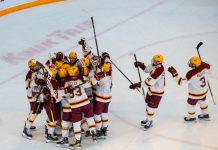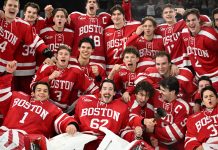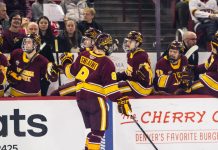Take a look at the six Division I college hockey programs with the most victories since the start of the 1998-99 season, and several familiar faces will turn up in that category.
North Dakota, Boston College, New Hampshire, Maine, Michigan and Michigan State have tasted victory more than any other schools across the nation in the past two and a half seasons. All six of those squads also boast an NCAA Tournament appearance to their credit, and the Fighting Sioux and Black Bears hold claim to the last two national titles.
But stationed at the No. 7 spot is a fresh face in the Division I ranks — Quinnipiac University. Despite the fact that the Braves are still in their infancy at the highest level of college hockey, they have proved to be somewhat of an overnight success. The Connecticut school has won 64 games over that span, even edging out nationally-recognized programs such as Wisconsin and Boston University in that department.
Unfortunately for Quinnipiac, the rest of those schools hold the upper hand where it matters the most — postseason appearances. After winning 27 and 26 games, respectively, in the past two seasons, the Braves are now in search of the first NCAA appearance in the history of the young program.
“It’s nice for the program because those are certainly [six] of the top programs in the country,” Quinnipiac coach Rand Pecknold said. “It’s nice to be considered with them, but realistically, we still have a long way to go to equal the success of a North Dakota or a Michigan. We have come a long way in our two and a half years of Division I hockey, but we’re still trying to work to catch up to those programs.”
Building on past experience
This season, the Braves have set the bar even higher than in recent years. Now that the MAAC tournament champion earns the automatic bid to the postseason, Quinnipiac no longer has to worry about sneaking in through the back door with an at-large bid. The days of buzz terms such as the “Big Four,” strength of schedule and PairWise Rankings are basically over if the Blue and Gold can take care of business on the ice.
All that the Nutmeg State school has to do to is reach the MAAC Tournament and then win the title in order to have a crack at the cream of the crop and, of course, a national championship. However, there are 10 other teams who would enjoy nothing more than denying the Braves the conference tournament title once again this March.
— QU athletic director Jack McDonald
In fact, Quinnipiac has been bounced out of the league tournament in the semifinals in each of the past two years. Canisius turned the trick in the 1998-99 campaign, while Iona eliminated the Braves last season.
Needless to say, the reminder of those dark days in March should provide some extra motivation for QU when the postseason rolls around this year — and even more so with a trip to the NCAA tournament on the line.
“I think that it’s certainly a motivating factor,” Pecknold said. “I don’t know how much the players are using it, but I’m certainly using it as a coach. I think that it will become more of a factor as we get closer to the playoffs. This year, there’s pressure on everyone because of the automatic bid.”
Of course, the Braves have maintained their winning ways this year. Despite dropping its last two league games to Mercyhurst and Cansius, Quinnipiac currently finds itself tied for third place with Connecticut.
And should the Braves continue their trend of rolling through conference play, then it wouldn’t be much of a surprise to find them in the hunt for the MAAC regular-season and tournament titles when March arrives.
Establishing a nationally-recognized program
Nestled at the base of Sleeping Giant State Park in Hamden, Conn., sits Quinnipiac, a postsecondary institution of around 6,000 students. The school was known as Quinnipiac College up until July of 2000, yet the Braves’ athletic program made the quantum leap to Division I athletics prior to the start of 1998-99 season.
Among those teams was Pecknold’s squad, which had posted a 19-3-1 record in its final year of Division II play. From there, Quinnipiac signed on as a charter member of the newly formed Metro Atlantic Athletic Conference and has dominated the league ever since. Since league play opened, the Blue and Gold have recorded a 53-8-6 mark against the rest of the conference.
“Like with some of our other sports, it really comes down to the leadership of the coaches and the quality of the student-athletes [reason for success],” Quinnipiac athletic director Jack McDonald said. “We were very fortunate to be able to make an upgrade to Division I. The bottom line is that Rand was winning when we were a Division II team, and he is continuing that as a Division I team.”
Over the course of the past two and a half seasons, the Braves have gained a reputation as an offensive juggernaut. Last year, they were the highest-scoring team in all of Division I hockey. Led by a talented unit of forwards including Chris Cerrella, Shawn Mansoff, Chad Poliquin and Jed Holtzman, Quinnipiac has had an easy time of putting up crooked numbers.
But that’s not to say that the Braves have been a pushover defensively, either. The combination of veterans, such as Anthony DiPalma, Mike LaRocca and Ben Blais, and a solid freshman class has spelled success for Pecknold’s squad. Though Quinnipiac did suffer a loss when junior blueliner Dan Ennis went down with a season-ending MCL injury in October, his teammates have helped to pick up the slack in his absence.
Then there’s the goaltending duo of senior J.C. Wells and freshman Justin Eddy. Wells has a record of 56-9-6 in his three-plus years between the pipes, while Eddy has established himself as one of the top young netminders in the nation. His 58-save effort in a 1-1 tie against St. Lawrence back in November set a QU single-game record.
So, with more experience on their side and a talented, veteran club, the Braves are hoping that this is the season that they put it all together and reach the NCAA tournament.
“One of the things that we did in the past two years, was that, for the most part, we showed up to play every game,” Pecknold said. “We didn’t take too many off nights, which we’ve already done a few times this year. You can’t just show up to play and expect to win.
“We have such huge junior and senior classes that this is really our year.”
Gaining some well-earned respect
Out of those 64 victories, one of the biggest came on Dec. 3 in Schenectady, N.Y., against an upstart Union College team. Up to that point, the Braves had posted a 0-6 record against teams from the ECAC and Hockey East, two of the established leagues in the nation.
(Since that game, QU has also played WCHA member Minnesota, losing 11-2. It has never faced a team from the CCHA.)
Yet for the better part of the past three seasons, the Braves have more or less been the Rodney Dangerfields of college hockey, getting little, if any, respect from the critics. Those outside of the Quinnipiac program blamed a soft league schedule for the high win totals, and pointed to the winless record against the “Big Four” members as a reason why it couldn’t be considered an upper-echelon program.
Nevertheless, a 3-2 win over the Dutchmen at Achilles Rink was another step in the right direction. Psychologically, the victory was a breakthrough that allowed the Braves to finally show the naysayers that they could experience success against veteran programs.
More importantly, Quinnipiac proved that it could win the close games, and not just outgun teams like it has been accustomed to doing since moving up to Division I.
“Everyone has criticized this program,” said Cerrella, a senior assistant captain. “They’ve said that our forwards don’t play defense, that our defensemen are more offensive-minded than defensive-minded, and that we don’t have a goalie that could win a big game. Now I think that we’ve proved everyone wrong.”
Added Pecknold: “Every year that I’ve been here, we’ve improved with every month and every game. We’ve been taking baby steps, and this win is another one of them. I’m not saying that it’s a drastic step, but it’s certainly an important piece of the puzzle.”
For the Quinnipiac players, the victory essentially removed the proverbial monkey from their backs. After years of being put under the microscope both as individuals and as team in comparison to their fellow Division I institutions, the Braves had something else to smile about.
“It was good for the program to beat one of the Big Four schools, but we had plenty of chances,” senior captain Shawn Mansoff said. “Now we must play every game hard, no matter who we are playing.”
Said Pecknold: “I think that a win like this certainly helps us in all areas. Our league has taken some heat, and we’ve taken some heat over the past few years. But you look at the MAAC now and our teams are getting wins and ties, and we’re playing the established leagues hard.”
Taking the road to respectability
One of the ways that the Braves have made a name for themselves has been their willingness to take on nonconference opponents, home or away. Last year, when defending national champion Maine called, Quinnipiac boarded the bus to Orono to face the Black Bears. The home team found itself trailing 4-3 after two periods until it rallied for a 7-4 win over the visitors.
Later in the season, ECAC member Clarkson visited the Northford Ice Pavilion and handed Quinnipiac a 4-0 loss, one of only two home losses as a Division I institution [20-2-2].
This season, Pecknold assembled a brutal nonconference slate that was comprised of all road games. Included in the lot was a weekend against Clarkson and St. Lawrence, another couplet against RPI and Union, and excursions to Minnesota and Cornell. Quinnipiac emerged from that sextet with a 1-3-2 mark, but took more away from those games than can be measured in wins and losses.
“Our tough nonconference schedule will definitely help us in the future, and it’s already helping us now,” Pecknold said. “Those games have taught our guys that we need to play better defense and compete at a higher level. Now what we’ve got to do is maintain some consistency throughout the rest of the season.
“Minnesota was a nice experience in terms of a great trip, playing in a great facility such as Mariucci [Arena] and seeing the great support that Minnesota gets from their fans. But the game was not a great experience at all. I was very disappointed in my team’s play. It was a learning experience, and we tried to take something positive from it.”
Said Minnesota hockey coach Don Lucia, “I’ve been on the other side of those games, back in 1981 when I was up in Alaska when they were just getting started. It’s the first time that those kids are playing in a big building, and maybe they were intimidated by it or a bit in awe. But I guarantee you that if we played them again, the score wouldn’t be like that … Our game was a bit of an aberration.”
But since the Braves have shown that they can play with the rest of the nation, the respect is slowly starting to seep in from various hockey circles — with regards to Quinnipiac’s ability as a program, but also regarding the development of the conference.
“When I came here as a freshman, you knew that we were going to Division I,” Cerrella said. “But people would look at the other teams in our league, and they would laugh. These other teams that we have been facing may have more experience, more depth, and more of a history in Division I hockey, but I think that we are proving that our league will take off if we continue to win.”
Completing the rise to power
With the success that the Braves have enjoyed in their first few seasons of Division I hockey, there is good reason to believe that the winning trend will continue down the road. Recruiting jaunts have helped Quinnipiac land players from as far as British Columbia, Alberta and Washington State.
“They’ve done a great job of going out and recruiting older junior hockey players, and that certainly helps,” Lucia said.
Support for the program has been present, both from the fans and the administration. However, there could be some changes for the better that take place in the next few years.
As far as facilities go, the Braves currently play in the Northford Ice Pavilion, a multipurpose facility that is about a 15-minute drive from campus. Quinnipiac shares time on the two rinks with a handful of high school hockey teams and even a few youth programs, but that may soon change with the planning of a new campus facility.
“We are in the process of formalizing plans to build a new on-campus rink that will seat between three and four thousand,” Pecknold said. “That’s the next big step for us, and it will help us get access to even better talent.”
Said McDonald, “With every day that goes by, the planning of the facility and construction gets closer. But it’s going to take a lot of time, effort, planning and money to get it done. It would be great for Quinnipiac, in addition to its league games, to attract some of the major programs in college hockey.”
On the ice, the Braves will also have to contend with a more experienced set of conference opponents down the road. After all, Quinnipiac hasn’t been the only MAAC program that has stepped outside of the league to test its skills. In fact, Sacred Heart marked up the first win by a conference member against one of the “Big Four” when it defeated Cornell back in October.
“The league has gotten so much better in the past year,” Pecknold said. “You can’t just show up anymore because it’s at a point now where anybody can beat anybody. The last-place team can beat the first-place team, and that’s something that wasn’t the case in the first or second year. We’re getting a little bit more parity in the league. The league and our program will continue to grow and improve within the next few years.”
“I hope at one point, it won’t be such a shock to people when they see that we beat a team like Union or tie teams like St. Lawrence and Cornell,” he added. “Hopefully, it will become a fairly commonplace thing.”
And if that is the case, then the Braves may be knocking on the door of college hockey’s established programs sooner rather than later. That’s a pretty impressive feat considering just how far they have come.
“I think of the days — and it was only five years ago — when we were playing in the Hamden Ice Rink,” McDonald said. “The schedule cards said that the games were at 7:30, but by the time they got everyone off of the ice from public skating and we started the game, it was 8:15. We’ve really come a long way in a very short period of time.”


